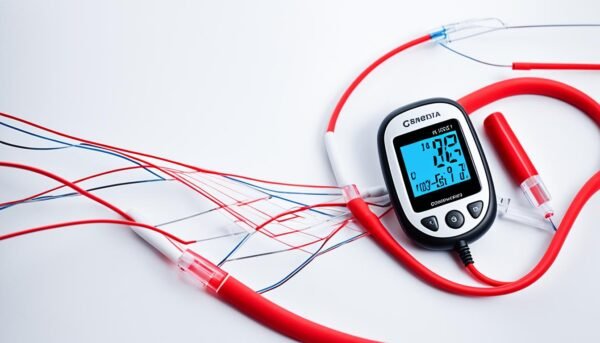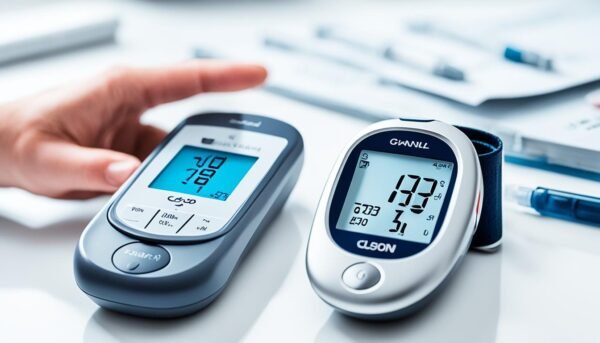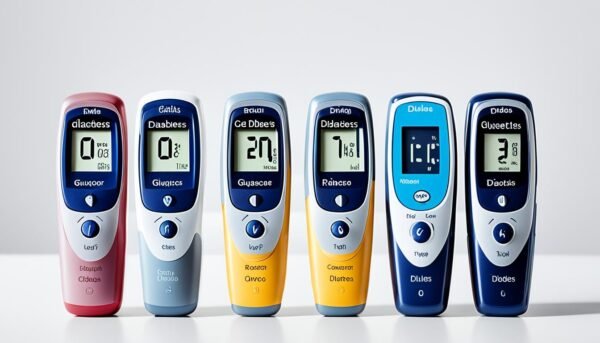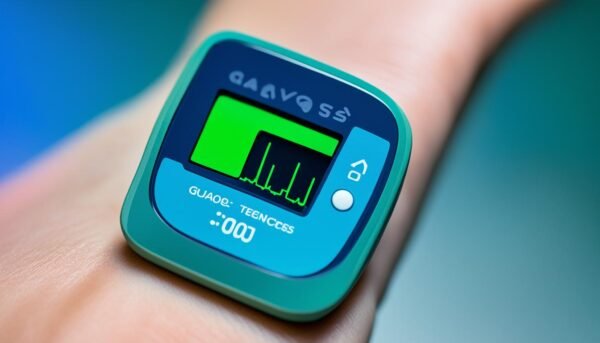Managing my type 2 diabetes has taught me the value of keeping an eye on my blood glucose levels. It’s crucial for staying healthy and avoiding serious health issues. But, finding the right blood sugar monitor can be tough with so many choices.
I’m excited to share my insights on the best blood sugar monitors for type 2 diabetes. This guide is for anyone, whether you’re new to diabetes or have been managing it for a while. We’ll look at everything from traditional meters to the latest continuous glucose monitoring (CGM) systems. You’ll learn about the top options and how to pick the right one for you.
Key Takeaways
- Proper blood glucose monitoring is essential for managing type 2 diabetes and preventing complications.
- There are numerous blood sugar monitors on the market, ranging from traditional fingerstick meters to advanced CGM systems.
- Factors to consider when choosing a blood glucose monitor include accuracy, ease of use, cost, and insurance coverage.
- Continuous glucose monitoring (CGM) systems offer valuable insights into your glucose trends and can help improve your diabetes management.
- Integrating your blood glucose data with digital platforms and apps can further enhance your diabetes self-care.
Understanding Blood Glucose Monitoring for Type 2 Diabetes
Keeping your blood sugar levels healthy is key for managing type 2 diabetes. Checking your blood sugar often helps you spot patterns and catch highs and lows. This way, you can make smart choices about your treatment and lifestyle. By checking your blood sugar regularly, you learn how your body reacts to food, exercise, and medicine.
Importance of Monitoring Blood Sugar Levels
It’s vital to check your blood sugar levels with type 2 diabetes. This lets you:
- See how your body reacts to food, activities, and medicines
- Spot patterns in your blood sugar levels
- Quickly treat low or high blood sugar
- Make smart choices about your treatment and lifestyle
- Lower the risk of serious problems from uncontrolled diabetes
Types of Blood Glucose Monitors
There are two main kinds of blood glucose monitors for type 2 diabetes:
- Fingerstick Glucose Meters: These devices need a tiny blood drop from your finger to check your sugar levels. They give fast and easy readings, letting you keep an eye on your levels all day.
- Continuous Glucose Monitoring (CGM) Systems: CGMs have a small sensor under your skin to track your glucose levels all the time. They show you your blood sugar changes, even at night, which is great for managing type 2 diabetes.
Fingerstick meters and CGM systems are both crucial for good blood glucose monitoring for type 2 diabetes. Knowing the good and bad of each helps you pick the best one for you and your life.

“Regular blood glucose monitoring is the cornerstone of effective type 2 diabetes management. It empowers you to make informed decisions and take control of your health.”
Factors to Consider When Choosing a Blood Glucose Monitor
Managing type 2 diabetes means your blood glucose monitor must be accurate and reliable. The data it gives you helps you make treatment choices and keep your blood sugar in check. When picking a monitor, think about these key factors to find the right one for you.
Accuracy and Precision
Accuracy is key when choosing a blood glucose monitor. Pick a device that has been tested and proven to give consistent, precise readings. This way, you can rely on the data to make smart choices about managing your diabetes.
Ease of Use
Checking your blood sugar every day can be a hassle. So, choose a monitor that’s simple to use. Look for big, clear displays, easy menus, and a painless testing method. This makes checking your levels a breeze, helping you stick to your diabetes care plan.
Cost and Insurance Coverage
The cost of blood glucose monitors and test strips is a big factor. Luckily, many insurance plans cover these costs for people with type 2 diabetes. Make sure to check your coverage to find a monitor that fits your budget.
Think about these factors carefully to find a blood glucose monitor that suits your health and wellness needs and helps you manage your diabetes well.

“Accurate, user-friendly blood glucose monitoring is the foundation of effective type 2 diabetes management.”
Top Blood Glucose Meters for Type 2 Diabetes
Managing type 2 diabetes means keeping an eye on your blood glucose levels. The right blood glucose meter can really help. There are several top options for type 2 diabetes that are worth looking at.
The Contour Next One is a favorite for its accuracy and easy design. It gives quick results and connects via Bluetooth for easy tracking. The Accu-Chek Guide is another top pick, with a big display and simple interface. It makes tracking your blood glucose easy.
For a budget-friendly option, consider the True Metrix Air. It’s small, has affordable test strips, and can store up to 1,000 readings. This makes it a great choice for managing your diabetes.
| Meter | Key Features | Pros | Cons |
|---|---|---|---|
| Contour Next One | – Fast results – Bluetooth connectivity – Customizable settings |
– Highly accurate – User-friendly design – Seamless data tracking |
– Slightly higher cost of test strips |
| Accu-Chek Guide | – Large display – Intuitive interface – Affordable test strips |
– Reliable accuracy – Easy to use – Convenient size |
– Limited data storage capacity |
| True Metrix Air | – Compact design – Stores up to 1,000 readings – Cost-effective test strips |
– Excellent value – Portable and discreet – Extensive memory |
– May not have advanced features |
When picking the best blood glucose meter for type 2 diabetes, think about what you need. Look at ease of use, accuracy, and if it fits your insurance. Choosing the right meter can help you manage your blood sugar well and stay healthy.

Continuous Glucose Monitoring (CGM) Systems
For people with type 2 diabetes, CGM systems are a step up from traditional blood sugar checks. They use a sensor under the skin to track glucose levels all the time. This gives you real-time data and alerts. It helps you spot trends, catch highs and lows, and manage your diabetes better.
Benefits of CGM for Type 2 Diabetes
Using a continuous glucose monitoring system for type 2 diabetes has many perks. It shows you how your blood sugar changes, helping you adjust your diet and meds. It alerts you to low blood sugar, so you can act fast. Plus, it helps you and your doctor find the best treatment plans.
Popular CGM Devices on the Market
Some top CGM systems for type 2 diabetes are:
- Dexcom G6
- FreeStyle Libre
- Eversense
Each device has its own special features. It’s key to talk with your doctor to find the right one for you.

“Continuous glucose monitoring has changed how I handle my type 2 diabetes. The real-time data and alerts let me control my blood sugar better and make smarter health choices.”
– Emily, a type 2 diabetes patient
best blood sugar monitors for type 2 diabetes
For managing type 2 diabetes, the right blood sugar monitor is key. The best blood sugar monitors for type 2 diabetes give accurate readings and are easy to use. They also fit your insurance plans. Top picks include the Contour Next One, the Accu-Chek Guide, and the FreeStyle Libre CGM system.
These devices offer features like Bluetooth connectivity and easy-to-read displays. They let you track your glucose levels over time. By taking a proactive approach, you can better control your type 2 diabetes and improve your health.
Key Features to Consider
- Accuracy and precision in blood sugar readings
- User-friendly interface and ease of use
- Compatibility with insurance coverage and cost-effectiveness
- Connectivity options, such as Bluetooth and smartphone integration
- Ability to track glucose trends and patterns over time
| Monitor | Features | Pros | Cons |
|---|---|---|---|
| Contour Next One | – Bluetooth connectivity – Intuitive color display – Customizable alerts |
– Highly accurate readings – Easy to use – Affordable with insurance |
– Requires separate lancing device |
| Accu-Chek Guide | – No coding required – Large, easy-to-read display – Built-in logbook |
– Accurate and reliable – Simple to operate – Compact and portable |
– May not be covered by all insurance plans |
| FreeStyle Libre CGM | – Continuous glucose monitoring – Wireless data transfer – Trend tracking and insights |
– Provides 24/7 glucose data – Eliminates the need for fingersticks – Helpful for identifying patterns |
– Higher cost than traditional meters – Requires a separate reader device |
When picking the best blood sugar monitor for type 2 diabetes, think about what you need and your insurance. Look for features that help you manage your diabetes well. The right monitor can greatly improve your health and disease management.
“Keeping a close eye on my blood sugar levels with the right monitor has been a game-changer in managing my type 2 diabetes. It’s empowered me to make more informed decisions about my health.”
Integrating Blood Glucose Data with Diabetes Management
Managing type 2 diabetes is more than just checking your blood sugar. It’s key to use your glucose data in your diabetes care plan. Now, many blood glucose monitors and CGM systems come with smartphone apps and digital platforms. These tools let you track your readings, get insights, and share your data with your doctor.
These digital tools help you spot patterns, set goals, and make smart choices about your diabetes care. By using your blood glucose data, you can understand your condition better. This helps you manage it better.
Smartphone Apps and Digital Platforms
Smartphone apps and digital platforms have changed how people with type 2 diabetes manage their health. These tools offer a place to:
- Log and track your blood glucose readings
- Get insights and advice just for you
- Remember to take your meds, eat, and exercise
- Talk to your healthcare team and share data safely
- Find educational resources and join support groups
Using smartphone apps and digital platforms for diabetes management helps you take charge of your type 2 diabetes. Combining your blood glucose data with your diabetes care leads to better decisions, improved health, and more control over your well-being.
| Feature | Benefit |
|---|---|
| Centralized data tracking | See all your blood glucose trends and patterns clearly |
| Personalized insights | Get advice that fits your diabetes care needs |
| Secure data sharing | Work well with your healthcare provider |
| Reminders and alerts | Keep up with your meds, meals, and exercise |
By using smartphone apps and digital platforms to combine your blood glucose data with diabetes management, you can manage your type 2 diabetes better. This leads to better health and a better life.
“Integrating my blood glucose data with my diabetes management plan has been a game-changer. The insights from the digital platform have helped me make more informed decisions and stay on top of my condition.”
Insulin Pumps and Closed-Loop Systems
Managing type 2 diabetes can feel like a constant challenge. But, there’s hope with advanced technologies like insulin pumps and closed-loop systems. They’re changing how we handle diabetes.
Insulin pumps are small devices that give insulin all day, like our bodies do naturally. Using insulin pumps for type 2 diabetes means we have more control over our blood sugar. We don’t need to give ourselves insulin shots as often.
Then, there’s the closed-loop system. It combines a continuous glucose monitoring (CGM) with an insulin pump. This system adjusts our insulin automatically based on our glucose levels. Closed-loop systems for type 2 diabetes help us manage our blood sugar better, which can improve our health.
“Insulin pumps and closed-loop systems have been life-changing for me. I no longer have to worry about the constant ups and downs of my blood sugar, and I feel more in control of my health than ever before.”
These technologies have their costs and insurance issues. But for those who can get them, the benefits are huge. By using these tools, we can manage our type 2 diabetes better. This leads to better health and a better life.
Tips for Accurate Blood Glucose Monitoring
Getting accurate blood glucose readings is key to managing type 2 diabetes well. To get reliable results, follow the right techniques for blood glucose monitoring. Also, keep your device in good shape.
Proper Technique for Blood Glucose Monitoring
When testing your blood sugar, make sure to:
- Use the recommended testing sites, such as the fingertips, to get accurate readings.
- Clean the testing area with soap and water, or an alcohol swab, to avoid contamination.
- Follow the specific instructions for your blood glucose monitor, including how to insert the test strip correctly.
- Avoid squeezing or ‘milking’ your finger too hard, as it can change the blood sample.
Maintaining Your Blood Glucose Monitor
To keep your blood glucose monitor working well, do the following:
- Calibrate your device regularly, as the manufacturer suggests.
- Replace the batteries, test strips, and any other parts that need it.
- Clean the monitor’s outside and testing port with a soft, dry cloth to stop dirt or debris from building up.
- Store your monitor and supplies in a cool, dry place, away from sunlight or extreme temperatures.
By using these tips for accurate blood glucose monitoring, you can be sure your readings are trustworthy. This helps you make better decisions about managing your diabetes.
“Accurate and consistent blood glucose monitoring is the foundation of effective diabetes management.”
| Technique Tips | Maintenance Tips |
|---|---|
| Use recommended testing sites | Regularly calibrate the device |
| Clean testing area to prevent contamination | Replace worn components as needed |
| Follow monitor instructions carefully | Keep the monitor clean and stored properly |
| Avoid excessive finger squeezing | – |
Insurance Coverage and Costs
Managing diabetes well depends a lot on checking your blood glucose often. But, the cost of these monitors and supplies can be high. Luckily, many insurance plans, like Medicaid and Medicare, cover some devices and tests.
What you pay out-of-pocket can change a lot based on your insurance. It’s key to talk to your provider to know what’s covered and any rules. Some companies and health groups also offer help to make these monitors cheaper for those who can’t afford them.
Let’s look at what you need to think about with insurance coverage for blood glucose monitors and the costs of blood glucose monitors:
- Find out what your insurance covers for blood glucose devices and supplies
- Ask about any deductibles, copays, or coinsurance for your blood glucose needs
- Look into programs from manufacturers or providers to lower the costs of monitors
- Work with your healthcare team to find the best, most affordable option for you
By doing your homework on insurance and looking for ways to save, you can make sure checking your blood glucose is both possible and affordable. This lets you take charge of managing your type 2 diabetes.
Emerging Technologies in Blood Glucose Monitoring
The world of blood glucose monitoring is changing fast. New technologies are coming out to make it easier and more accurate for people with type 2 diabetes to manage their condition. One big step is the FDA-approved Dexcom Stelo Glucose Biosensor System. It’s the first CGM you can buy without a prescription.
Smartwatches and other wearable devices are also being tested to track blood sugar levels. These new tools are promising, but it’s key to talk to your doctor before using them. They need to be sure they’re safe and right for you. I’ve learned that talking openly with my doctor helps a lot in understanding these new options.
As someone living with type 2 diabetes, I’m always looking for new ways to get healthier. These new blood glucose monitoring technologies are exciting, but they shouldn’t replace what your doctor says. It’s important to stay informed and work with your healthcare team. Together, we can find the best ways to manage diabetes and live well.
FAQ
What are the best blood glucose monitors for managing type 2 diabetes?
Top blood glucose meters for type 2 diabetes include the Contour Next One, the Accu-Chek Guide, and the True Metrix Air. They offer fast results, Bluetooth connectivity, and affordable test strips.
What are the different types of blood glucose monitors?
There are two main types: traditional fingerstick glucose meters and continuous glucose monitoring (CGM) systems. Fingerstick meters need a small blood drop from your fingertip. CGMs use a sensor under your skin to track glucose levels continuously.
What factors should I consider when choosing a blood glucose monitor?
Look for accuracy, ease of use, and cost when picking a blood glucose monitor. Accuracy is key for managing your diabetes well. Ease of use and insurance coverage also matter.
What are the benefits of using a continuous glucose monitoring (CGM) system?
CGM systems give you real-time data and alerts. They help you spot patterns, catch highs and lows, and manage your diabetes better. Popular devices include the Dexcom G6, the FreeStyle Libre, and the Eversense system.
How can I integrate my blood glucose data with my overall diabetes management plan?
Many monitors and CGM systems come with apps and digital platforms. These let you track readings, get insights, and share data with your doctor. They help you set goals and make smart treatment choices.
What are the latest advancements in blood glucose monitoring technology?
Blood glucose monitoring is getting better with new tech like the Dexcom Stelo Glucose Biosensor System and smartwatch devices. But, always talk to your doctor to make sure these are right for you.
Source Links
- 10 Best Glucose Monitors and Meters – https://www.healthline.com/health/diabetes/best-glucose-monitors
- What You Need to Know Before Buying an At-Home Glucose Monitor – https://www.goodhousekeeping.com/health-products/g60334719/best-glucose-monitors/
- Diabetes Devices & Technology | ADA – https://diabetes.org/about-diabetes/devices-technology
This post may contain affiliate links which means I may receive a commission for purchases made through links. I will only recommend products that I have personally used! Learn more on my Private Policy page.